Business Finance: Financial Statement Analysis and Ratio Application
VerifiedAdded on 2023/06/18
|11
|2478
|234
Report
AI Summary
This report provides an overview of financial management and its importance in corporate finance. It discusses the role of financial statements, including the balance sheet, income statement, and cash flow statement, in assessing a company's financial health. The report includes calculations of key financial ratios such as gross profit margin, net profit margin, current ratio, and quick ratio, and explains how these ratios are used to evaluate a company's profitability, liquidity, and efficiency. It highlights the importance of financial planning in making informed business decisions, procuring and utilizing funds effectively, and increasing profitability. The report concludes that financial administration is crucial for a company's survival and growth, enabling effective management of financial operations and informed decision-making to improve productivity and long-term performance. Desklib offers more solved assignments and resources for students.
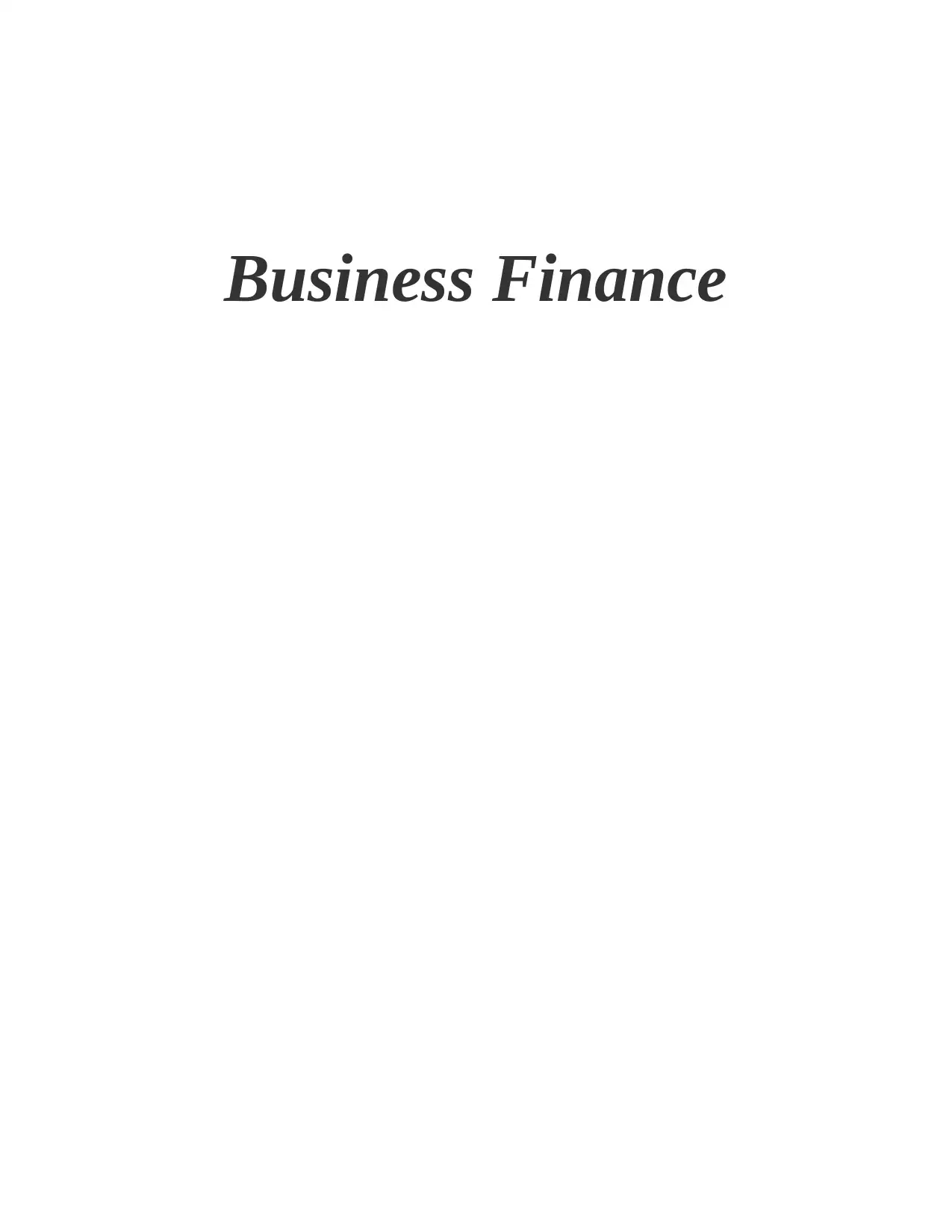
Business Finance
Paraphrase This Document
Need a fresh take? Get an instant paraphrase of this document with our AI Paraphraser
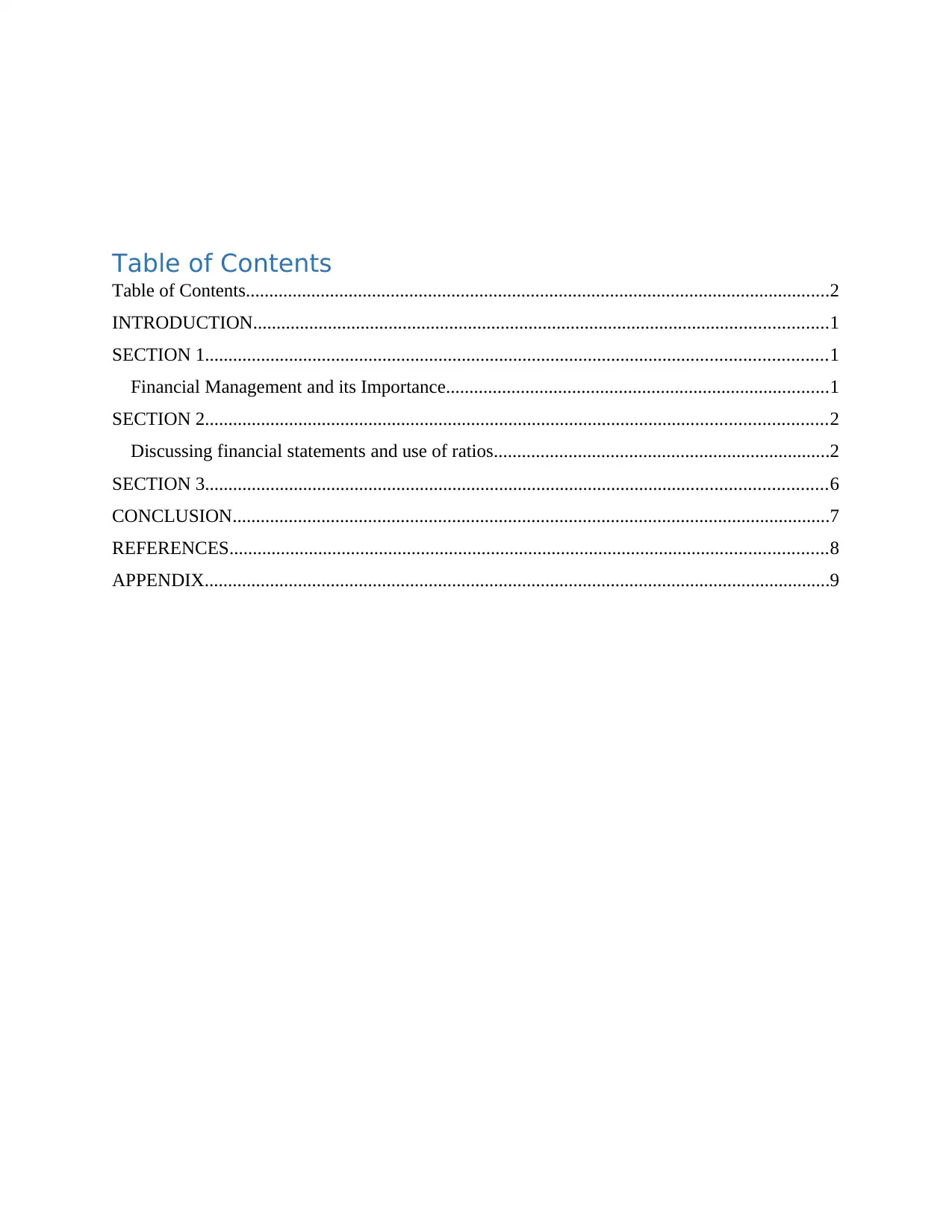
Table of Contents
Table of Contents.............................................................................................................................2
INTRODUCTION...........................................................................................................................1
SECTION 1.....................................................................................................................................1
Financial Management and its Importance..................................................................................1
SECTION 2.....................................................................................................................................2
Discussing financial statements and use of ratios........................................................................2
SECTION 3.....................................................................................................................................6
CONCLUSION................................................................................................................................7
REFERENCES................................................................................................................................8
APPENDIX......................................................................................................................................9
Table of Contents.............................................................................................................................2
INTRODUCTION...........................................................................................................................1
SECTION 1.....................................................................................................................................1
Financial Management and its Importance..................................................................................1
SECTION 2.....................................................................................................................................2
Discussing financial statements and use of ratios........................................................................2
SECTION 3.....................................................................................................................................6
CONCLUSION................................................................................................................................7
REFERENCES................................................................................................................................8
APPENDIX......................................................................................................................................9
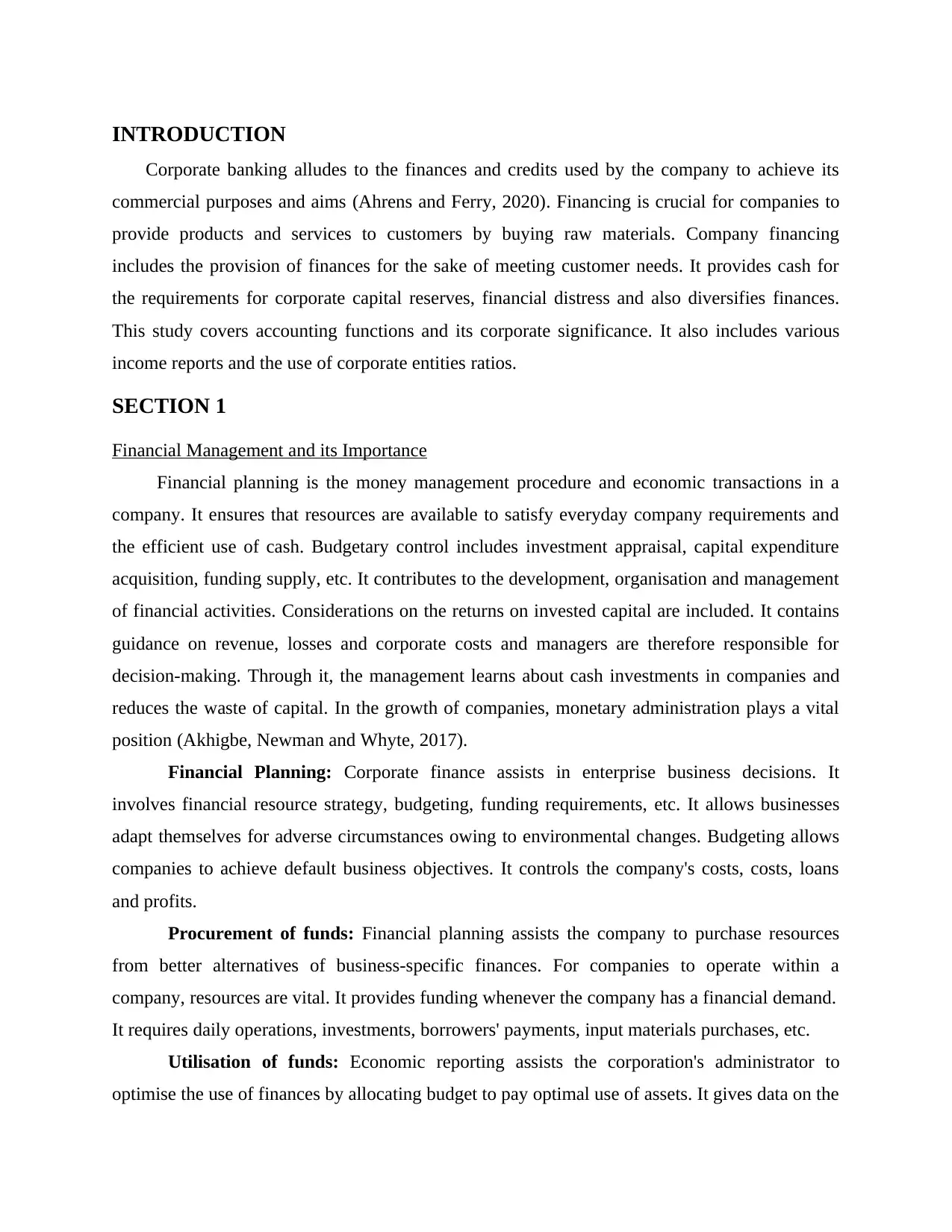
INTRODUCTION
Corporate banking alludes to the finances and credits used by the company to achieve its
commercial purposes and aims (Ahrens and Ferry, 2020). Financing is crucial for companies to
provide products and services to customers by buying raw materials. Company financing
includes the provision of finances for the sake of meeting customer needs. It provides cash for
the requirements for corporate capital reserves, financial distress and also diversifies finances.
This study covers accounting functions and its corporate significance. It also includes various
income reports and the use of corporate entities ratios.
SECTION 1
Financial Management and its Importance
Financial planning is the money management procedure and economic transactions in a
company. It ensures that resources are available to satisfy everyday company requirements and
the efficient use of cash. Budgetary control includes investment appraisal, capital expenditure
acquisition, funding supply, etc. It contributes to the development, organisation and management
of financial activities. Considerations on the returns on invested capital are included. It contains
guidance on revenue, losses and corporate costs and managers are therefore responsible for
decision-making. Through it, the management learns about cash investments in companies and
reduces the waste of capital. In the growth of companies, monetary administration plays a vital
position (Akhigbe, Newman and Whyte, 2017).
Financial Planning: Corporate finance assists in enterprise business decisions. It
involves financial resource strategy, budgeting, funding requirements, etc. It allows businesses
adapt themselves for adverse circumstances owing to environmental changes. Budgeting allows
companies to achieve default business objectives. It controls the company's costs, costs, loans
and profits.
Procurement of funds: Financial planning assists the company to purchase resources
from better alternatives of business-specific finances. For companies to operate within a
company, resources are vital. It provides funding whenever the company has a financial demand.
It requires daily operations, investments, borrowers' payments, input materials purchases, etc.
Utilisation of funds: Economic reporting assists the corporation's administrator to
optimise the use of finances by allocating budget to pay optimal use of assets. It gives data on the
Corporate banking alludes to the finances and credits used by the company to achieve its
commercial purposes and aims (Ahrens and Ferry, 2020). Financing is crucial for companies to
provide products and services to customers by buying raw materials. Company financing
includes the provision of finances for the sake of meeting customer needs. It provides cash for
the requirements for corporate capital reserves, financial distress and also diversifies finances.
This study covers accounting functions and its corporate significance. It also includes various
income reports and the use of corporate entities ratios.
SECTION 1
Financial Management and its Importance
Financial planning is the money management procedure and economic transactions in a
company. It ensures that resources are available to satisfy everyday company requirements and
the efficient use of cash. Budgetary control includes investment appraisal, capital expenditure
acquisition, funding supply, etc. It contributes to the development, organisation and management
of financial activities. Considerations on the returns on invested capital are included. It contains
guidance on revenue, losses and corporate costs and managers are therefore responsible for
decision-making. Through it, the management learns about cash investments in companies and
reduces the waste of capital. In the growth of companies, monetary administration plays a vital
position (Akhigbe, Newman and Whyte, 2017).
Financial Planning: Corporate finance assists in enterprise business decisions. It
involves financial resource strategy, budgeting, funding requirements, etc. It allows businesses
adapt themselves for adverse circumstances owing to environmental changes. Budgeting allows
companies to achieve default business objectives. It controls the company's costs, costs, loans
and profits.
Procurement of funds: Financial planning assists the company to purchase resources
from better alternatives of business-specific finances. For companies to operate within a
company, resources are vital. It provides funding whenever the company has a financial demand.
It requires daily operations, investments, borrowers' payments, input materials purchases, etc.
Utilisation of funds: Economic reporting assists the corporation's administrator to
optimise the use of finances by allocating budget to pay optimal use of assets. It gives data on the
⊘ This is a preview!⊘
Do you want full access?
Subscribe today to unlock all pages.

Trusted by 1+ million students worldwide
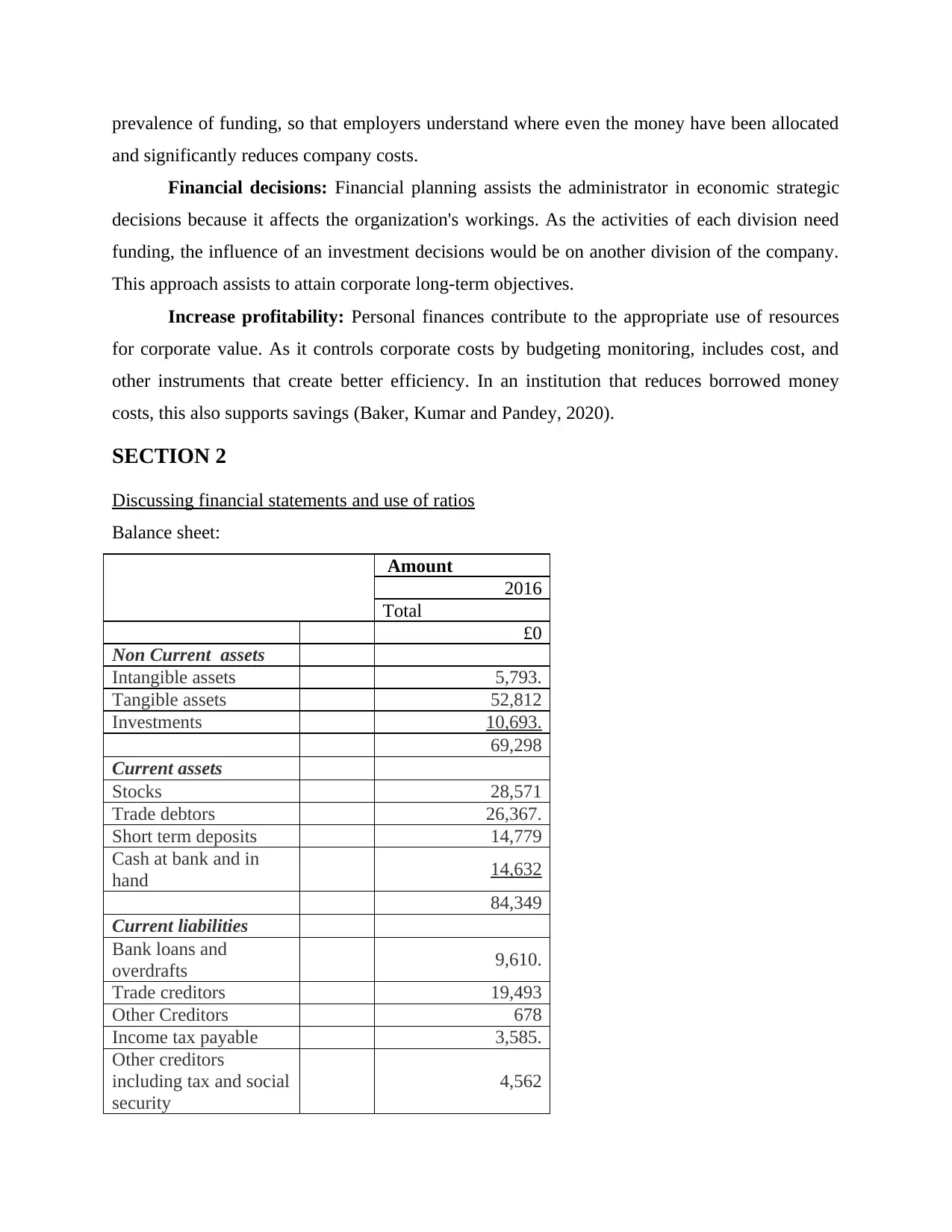
prevalence of funding, so that employers understand where even the money have been allocated
and significantly reduces company costs.
Financial decisions: Financial planning assists the administrator in economic strategic
decisions because it affects the organization's workings. As the activities of each division need
funding, the influence of an investment decisions would be on another division of the company.
This approach assists to attain corporate long-term objectives.
Increase profitability: Personal finances contribute to the appropriate use of resources
for corporate value. As it controls corporate costs by budgeting monitoring, includes cost, and
other instruments that create better efficiency. In an institution that reduces borrowed money
costs, this also supports savings (Baker, Kumar and Pandey, 2020).
SECTION 2
Discussing financial statements and use of ratios
Balance sheet:
Amount
2016
Total
£0
Non Current assets
Intangible assets 5,793.
Tangible assets 52,812
Investments 10,693.
69,298
Current assets
Stocks 28,571
Trade debtors 26,367.
Short term deposits 14,779
Cash at bank and in
hand 14,632
84,349
Current liabilities
Bank loans and
overdrafts 9,610.
Trade creditors 19,493
Other Creditors 678
Income tax payable 3,585.
Other creditors
including tax and social
security
4,562
and significantly reduces company costs.
Financial decisions: Financial planning assists the administrator in economic strategic
decisions because it affects the organization's workings. As the activities of each division need
funding, the influence of an investment decisions would be on another division of the company.
This approach assists to attain corporate long-term objectives.
Increase profitability: Personal finances contribute to the appropriate use of resources
for corporate value. As it controls corporate costs by budgeting monitoring, includes cost, and
other instruments that create better efficiency. In an institution that reduces borrowed money
costs, this also supports savings (Baker, Kumar and Pandey, 2020).
SECTION 2
Discussing financial statements and use of ratios
Balance sheet:
Amount
2016
Total
£0
Non Current assets
Intangible assets 5,793.
Tangible assets 52,812
Investments 10,693.
69,298
Current assets
Stocks 28,571
Trade debtors 26,367.
Short term deposits 14,779
Cash at bank and in
hand 14,632
84,349
Current liabilities
Bank loans and
overdrafts 9,610.
Trade creditors 19,493
Other Creditors 678
Income tax payable 3,585.
Other creditors
including tax and social
security
4,562
Paraphrase This Document
Need a fresh take? Get an instant paraphrase of this document with our AI Paraphraser
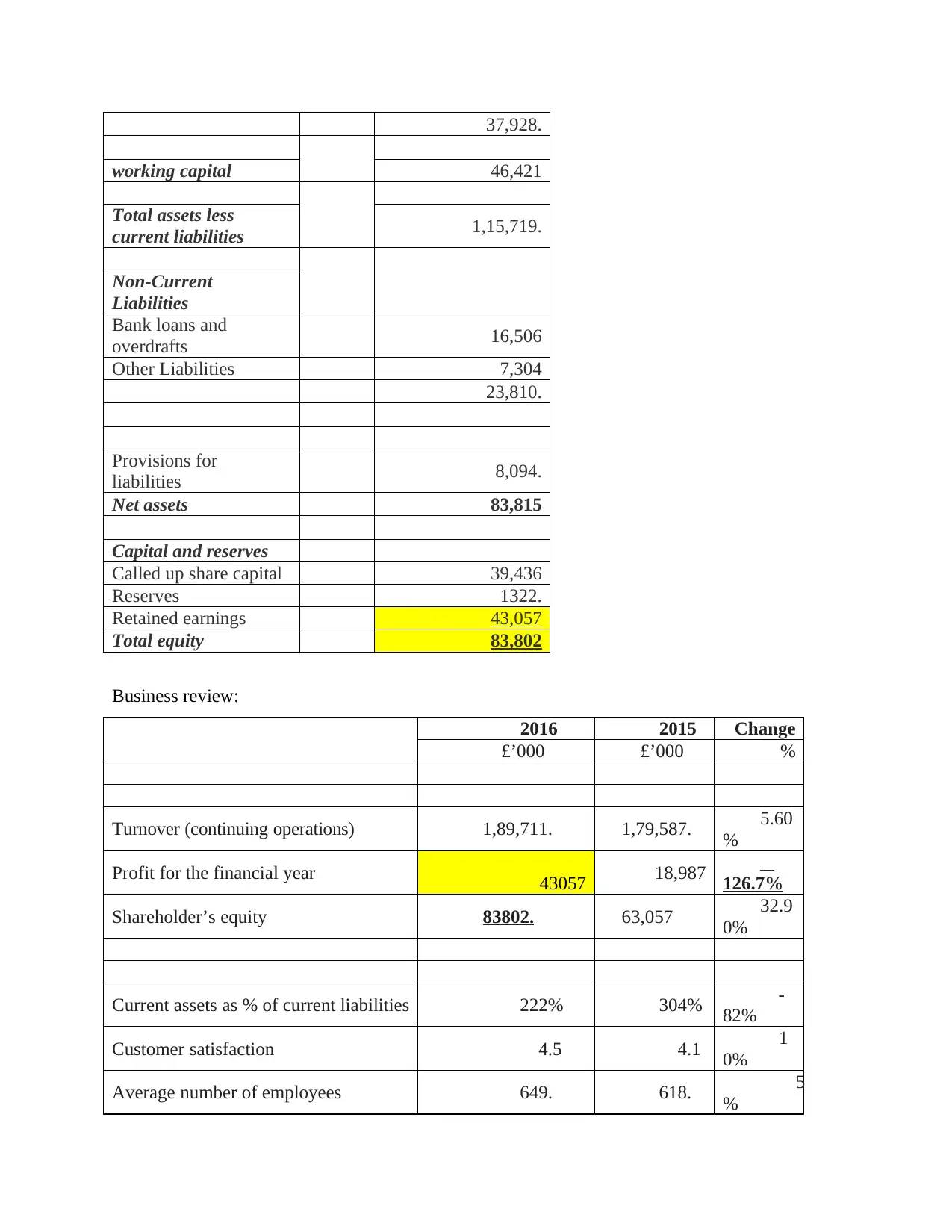
37,928.
working capital 46,421
Total assets less
current liabilities 1,15,719.
Non-Current
Liabilities
Bank loans and
overdrafts 16,506
Other Liabilities 7,304
23,810.
Provisions for
liabilities 8,094.
Net assets 83,815
Capital and reserves
Called up share capital 39,436
Reserves 1322.
Retained earnings 43,057
Total equity 83,802
Business review:
2016 2015 Change
£’000 £’000 %
Turnover (continuing operations) 1,89,711. 1,79,587. 5.60
%
Profit for the financial year 43057 18,987 126.7%
Shareholder’s equity 83802. 63,057 32.9
0%
Current assets as % of current liabilities 222% 304% -
82%
Customer satisfaction 4.5 4.1 1
0%
Average number of employees 649. 618. 5
%
working capital 46,421
Total assets less
current liabilities 1,15,719.
Non-Current
Liabilities
Bank loans and
overdrafts 16,506
Other Liabilities 7,304
23,810.
Provisions for
liabilities 8,094.
Net assets 83,815
Capital and reserves
Called up share capital 39,436
Reserves 1322.
Retained earnings 43,057
Total equity 83,802
Business review:
2016 2015 Change
£’000 £’000 %
Turnover (continuing operations) 1,89,711. 1,79,587. 5.60
%
Profit for the financial year 43057 18,987 126.7%
Shareholder’s equity 83802. 63,057 32.9
0%
Current assets as % of current liabilities 222% 304% -
82%
Customer satisfaction 4.5 4.1 1
0%
Average number of employees 649. 618. 5
%
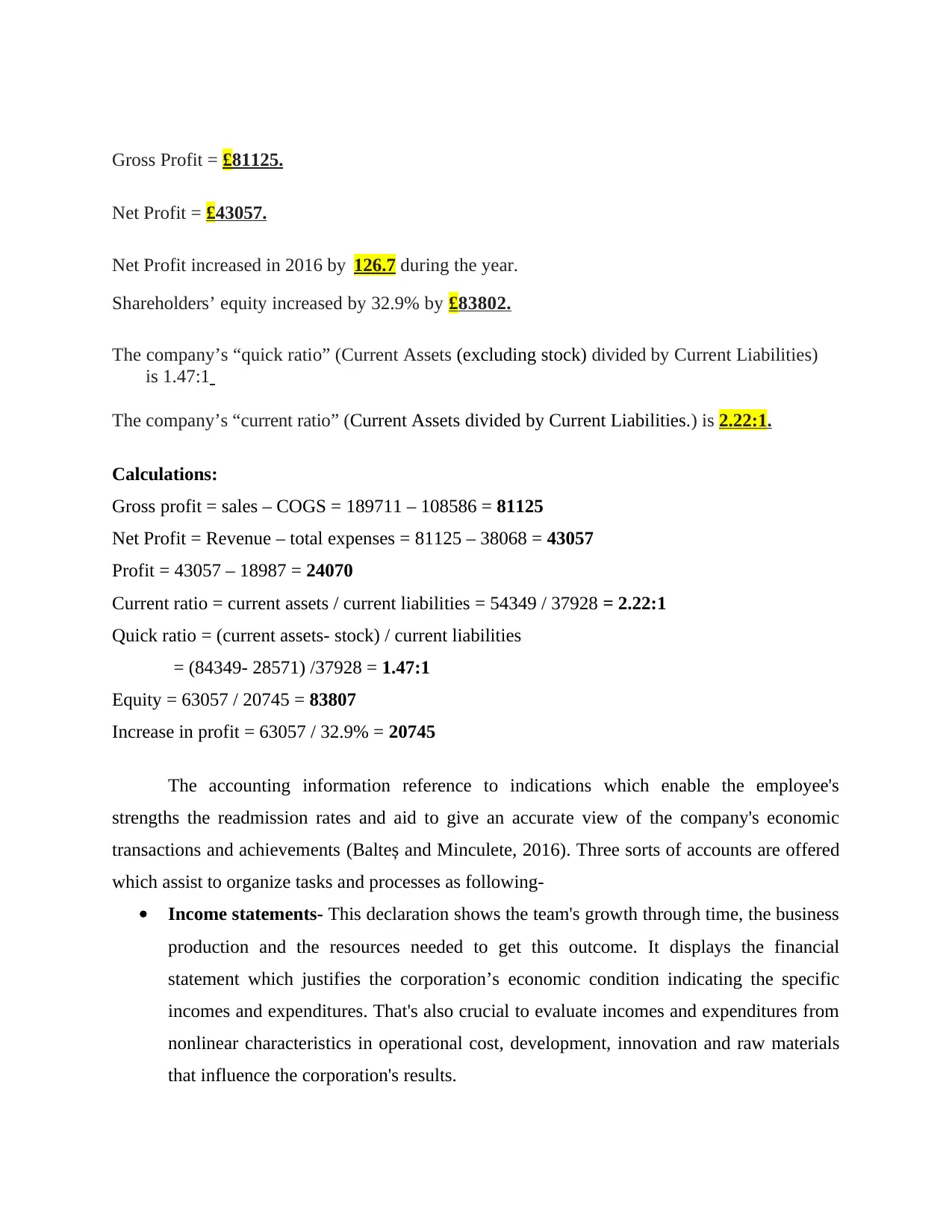
Gross Profit = £81125.
Net Profit = £43057.
Net Profit increased in 2016 by 126.7 during the year.
Shareholders’ equity increased by 32.9% by £83802.
The company’s “quick ratio” (Current Assets (excluding stock) divided by Current Liabilities)
is 1.47:1
The company’s “current ratio” (Current Assets divided by Current Liabilities.) is 2.22:1.
Calculations:
Gross profit = sales – COGS = 189711 – 108586 = 81125
Net Profit = Revenue – total expenses = 81125 – 38068 = 43057
Profit = 43057 – 18987 = 24070
Current ratio = current assets / current liabilities = 54349 / 37928 = 2.22:1
Quick ratio = (current assets- stock) / current liabilities
= (84349- 28571) /37928 = 1.47:1
Equity = 63057 / 20745 = 83807
Increase in profit = 63057 / 32.9% = 20745
The accounting information reference to indications which enable the employee's
strengths the readmission rates and aid to give an accurate view of the company's economic
transactions and achievements (Balteș and Minculete, 2016). Three sorts of accounts are offered
which assist to organize tasks and processes as following-
Income statements- This declaration shows the team's growth through time, the business
production and the resources needed to get this outcome. It displays the financial
statement which justifies the corporation’s economic condition indicating the specific
incomes and expenditures. That's also crucial to evaluate incomes and expenditures from
nonlinear characteristics in operational cost, development, innovation and raw materials
that influence the corporation's results.
Net Profit = £43057.
Net Profit increased in 2016 by 126.7 during the year.
Shareholders’ equity increased by 32.9% by £83802.
The company’s “quick ratio” (Current Assets (excluding stock) divided by Current Liabilities)
is 1.47:1
The company’s “current ratio” (Current Assets divided by Current Liabilities.) is 2.22:1.
Calculations:
Gross profit = sales – COGS = 189711 – 108586 = 81125
Net Profit = Revenue – total expenses = 81125 – 38068 = 43057
Profit = 43057 – 18987 = 24070
Current ratio = current assets / current liabilities = 54349 / 37928 = 2.22:1
Quick ratio = (current assets- stock) / current liabilities
= (84349- 28571) /37928 = 1.47:1
Equity = 63057 / 20745 = 83807
Increase in profit = 63057 / 32.9% = 20745
The accounting information reference to indications which enable the employee's
strengths the readmission rates and aid to give an accurate view of the company's economic
transactions and achievements (Balteș and Minculete, 2016). Three sorts of accounts are offered
which assist to organize tasks and processes as following-
Income statements- This declaration shows the team's growth through time, the business
production and the resources needed to get this outcome. It displays the financial
statement which justifies the corporation’s economic condition indicating the specific
incomes and expenditures. That's also crucial to evaluate incomes and expenditures from
nonlinear characteristics in operational cost, development, innovation and raw materials
that influence the corporation's results.
⊘ This is a preview!⊘
Do you want full access?
Subscribe today to unlock all pages.

Trusted by 1+ million students worldwide
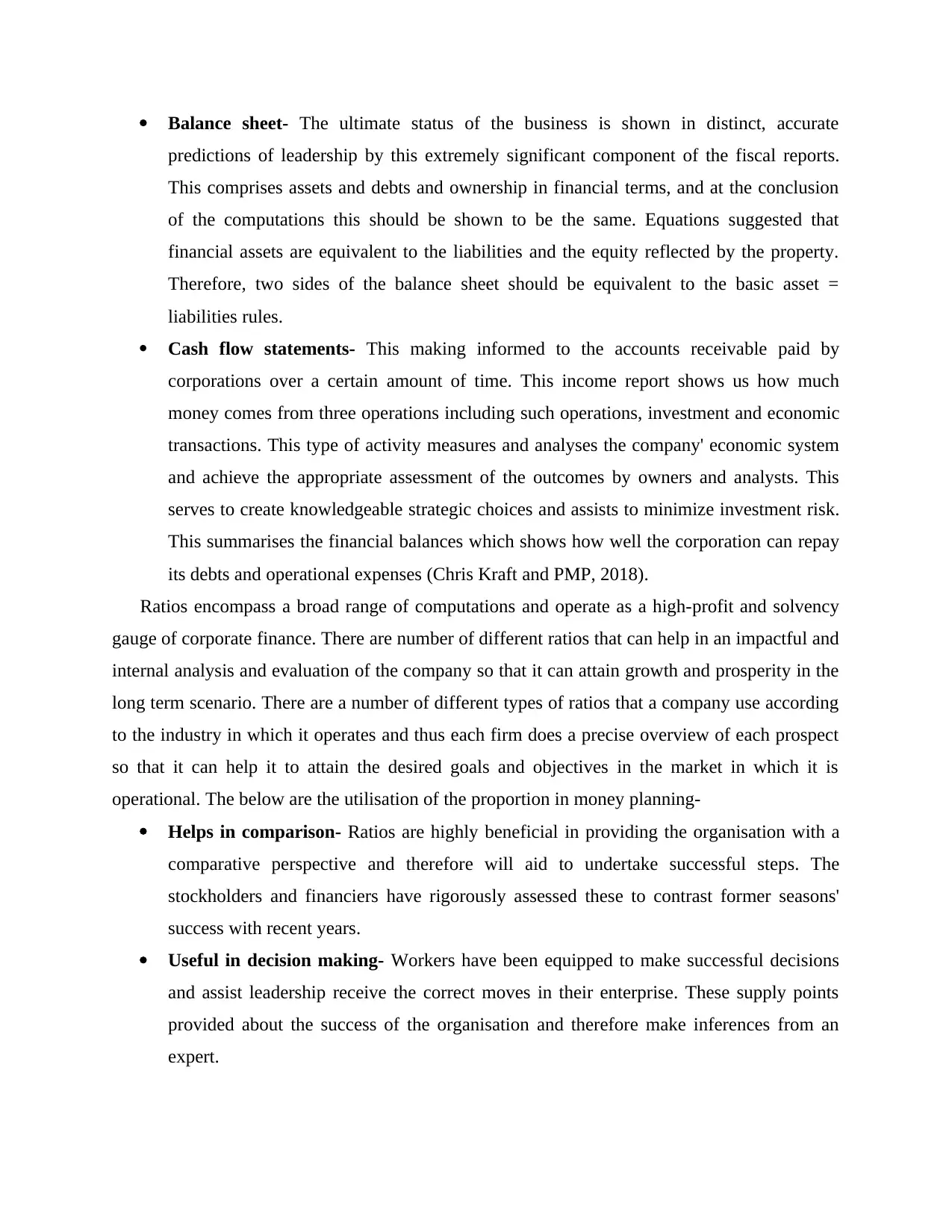
Balance sheet- The ultimate status of the business is shown in distinct, accurate
predictions of leadership by this extremely significant component of the fiscal reports.
This comprises assets and debts and ownership in financial terms, and at the conclusion
of the computations this should be shown to be the same. Equations suggested that
financial assets are equivalent to the liabilities and the equity reflected by the property.
Therefore, two sides of the balance sheet should be equivalent to the basic asset =
liabilities rules.
Cash flow statements- This making informed to the accounts receivable paid by
corporations over a certain amount of time. This income report shows us how much
money comes from three operations including such operations, investment and economic
transactions. This type of activity measures and analyses the company' economic system
and achieve the appropriate assessment of the outcomes by owners and analysts. This
serves to create knowledgeable strategic choices and assists to minimize investment risk.
This summarises the financial balances which shows how well the corporation can repay
its debts and operational expenses (Chris Kraft and PMP, 2018).
Ratios encompass a broad range of computations and operate as a high-profit and solvency
gauge of corporate finance. There are number of different ratios that can help in an impactful and
internal analysis and evaluation of the company so that it can attain growth and prosperity in the
long term scenario. There are a number of different types of ratios that a company use according
to the industry in which it operates and thus each firm does a precise overview of each prospect
so that it can help it to attain the desired goals and objectives in the market in which it is
operational. The below are the utilisation of the proportion in money planning-
Helps in comparison- Ratios are highly beneficial in providing the organisation with a
comparative perspective and therefore will aid to undertake successful steps. The
stockholders and financiers have rigorously assessed these to contrast former seasons'
success with recent years.
Useful in decision making- Workers have been equipped to make successful decisions
and assist leadership receive the correct moves in their enterprise. These supply points
provided about the success of the organisation and therefore make inferences from an
expert.
predictions of leadership by this extremely significant component of the fiscal reports.
This comprises assets and debts and ownership in financial terms, and at the conclusion
of the computations this should be shown to be the same. Equations suggested that
financial assets are equivalent to the liabilities and the equity reflected by the property.
Therefore, two sides of the balance sheet should be equivalent to the basic asset =
liabilities rules.
Cash flow statements- This making informed to the accounts receivable paid by
corporations over a certain amount of time. This income report shows us how much
money comes from three operations including such operations, investment and economic
transactions. This type of activity measures and analyses the company' economic system
and achieve the appropriate assessment of the outcomes by owners and analysts. This
serves to create knowledgeable strategic choices and assists to minimize investment risk.
This summarises the financial balances which shows how well the corporation can repay
its debts and operational expenses (Chris Kraft and PMP, 2018).
Ratios encompass a broad range of computations and operate as a high-profit and solvency
gauge of corporate finance. There are number of different ratios that can help in an impactful and
internal analysis and evaluation of the company so that it can attain growth and prosperity in the
long term scenario. There are a number of different types of ratios that a company use according
to the industry in which it operates and thus each firm does a precise overview of each prospect
so that it can help it to attain the desired goals and objectives in the market in which it is
operational. The below are the utilisation of the proportion in money planning-
Helps in comparison- Ratios are highly beneficial in providing the organisation with a
comparative perspective and therefore will aid to undertake successful steps. The
stockholders and financiers have rigorously assessed these to contrast former seasons'
success with recent years.
Useful in decision making- Workers have been equipped to make successful decisions
and assist leadership receive the correct moves in their enterprise. These supply points
provided about the success of the organisation and therefore make inferences from an
expert.
Paraphrase This Document
Need a fresh take? Get an instant paraphrase of this document with our AI Paraphraser
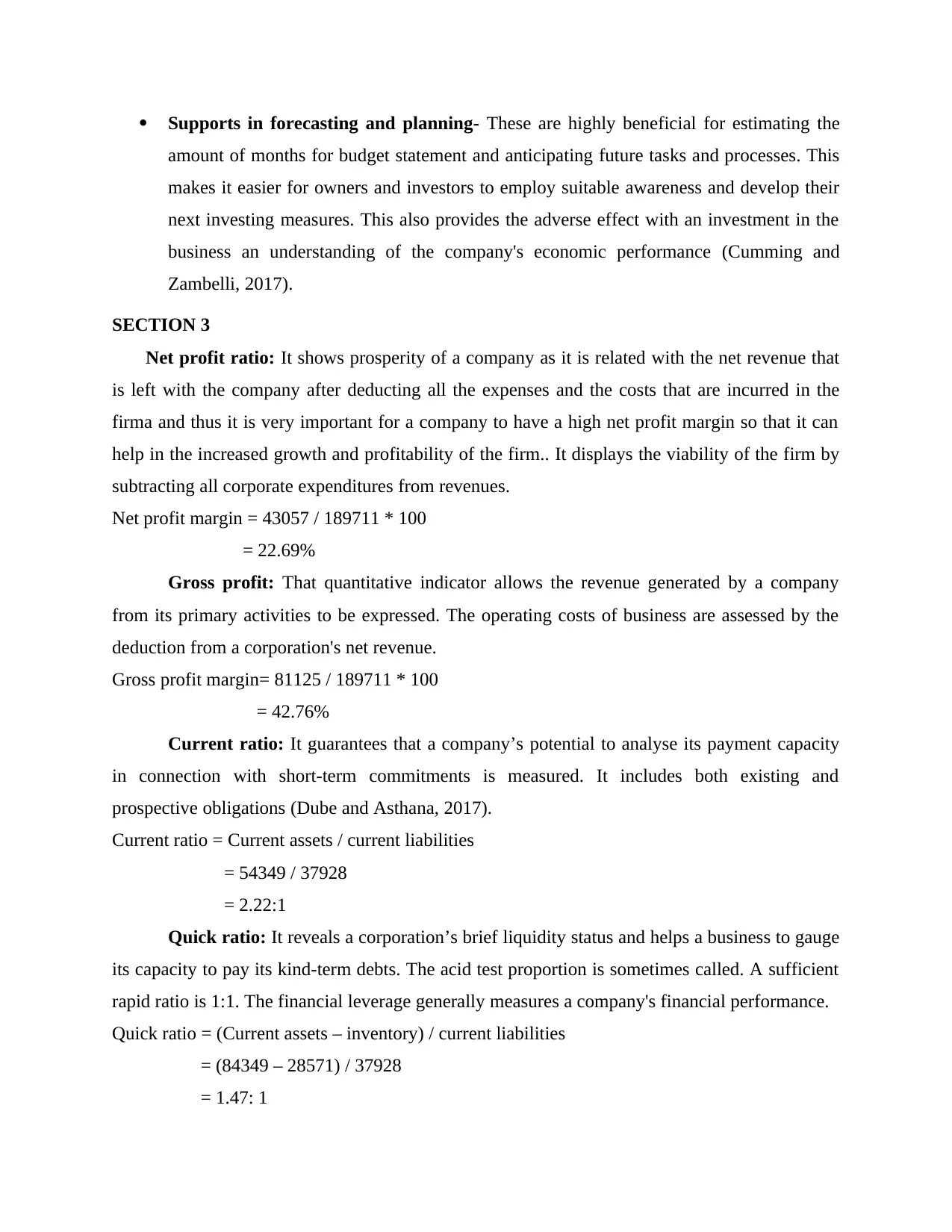
Supports in forecasting and planning- These are highly beneficial for estimating the
amount of months for budget statement and anticipating future tasks and processes. This
makes it easier for owners and investors to employ suitable awareness and develop their
next investing measures. This also provides the adverse effect with an investment in the
business an understanding of the company's economic performance (Cumming and
Zambelli, 2017).
SECTION 3
Net profit ratio: It shows prosperity of a company as it is related with the net revenue that
is left with the company after deducting all the expenses and the costs that are incurred in the
firma and thus it is very important for a company to have a high net profit margin so that it can
help in the increased growth and profitability of the firm.. It displays the viability of the firm by
subtracting all corporate expenditures from revenues.
Net profit margin = 43057 / 189711 * 100
= 22.69%
Gross profit: That quantitative indicator allows the revenue generated by a company
from its primary activities to be expressed. The operating costs of business are assessed by the
deduction from a corporation's net revenue.
Gross profit margin= 81125 / 189711 * 100
= 42.76%
Current ratio: It guarantees that a company’s potential to analyse its payment capacity
in connection with short-term commitments is measured. It includes both existing and
prospective obligations (Dube and Asthana, 2017).
Current ratio = Current assets / current liabilities
= 54349 / 37928
= 2.22:1
Quick ratio: It reveals a corporation’s brief liquidity status and helps a business to gauge
its capacity to pay its kind-term debts. The acid test proportion is sometimes called. A sufficient
rapid ratio is 1:1. The financial leverage generally measures a company's financial performance.
Quick ratio = (Current assets – inventory) / current liabilities
= (84349 – 28571) / 37928
= 1.47: 1
amount of months for budget statement and anticipating future tasks and processes. This
makes it easier for owners and investors to employ suitable awareness and develop their
next investing measures. This also provides the adverse effect with an investment in the
business an understanding of the company's economic performance (Cumming and
Zambelli, 2017).
SECTION 3
Net profit ratio: It shows prosperity of a company as it is related with the net revenue that
is left with the company after deducting all the expenses and the costs that are incurred in the
firma and thus it is very important for a company to have a high net profit margin so that it can
help in the increased growth and profitability of the firm.. It displays the viability of the firm by
subtracting all corporate expenditures from revenues.
Net profit margin = 43057 / 189711 * 100
= 22.69%
Gross profit: That quantitative indicator allows the revenue generated by a company
from its primary activities to be expressed. The operating costs of business are assessed by the
deduction from a corporation's net revenue.
Gross profit margin= 81125 / 189711 * 100
= 42.76%
Current ratio: It guarantees that a company’s potential to analyse its payment capacity
in connection with short-term commitments is measured. It includes both existing and
prospective obligations (Dube and Asthana, 2017).
Current ratio = Current assets / current liabilities
= 54349 / 37928
= 2.22:1
Quick ratio: It reveals a corporation’s brief liquidity status and helps a business to gauge
its capacity to pay its kind-term debts. The acid test proportion is sometimes called. A sufficient
rapid ratio is 1:1. The financial leverage generally measures a company's financial performance.
Quick ratio = (Current assets – inventory) / current liabilities
= (84349 – 28571) / 37928
= 1.47: 1
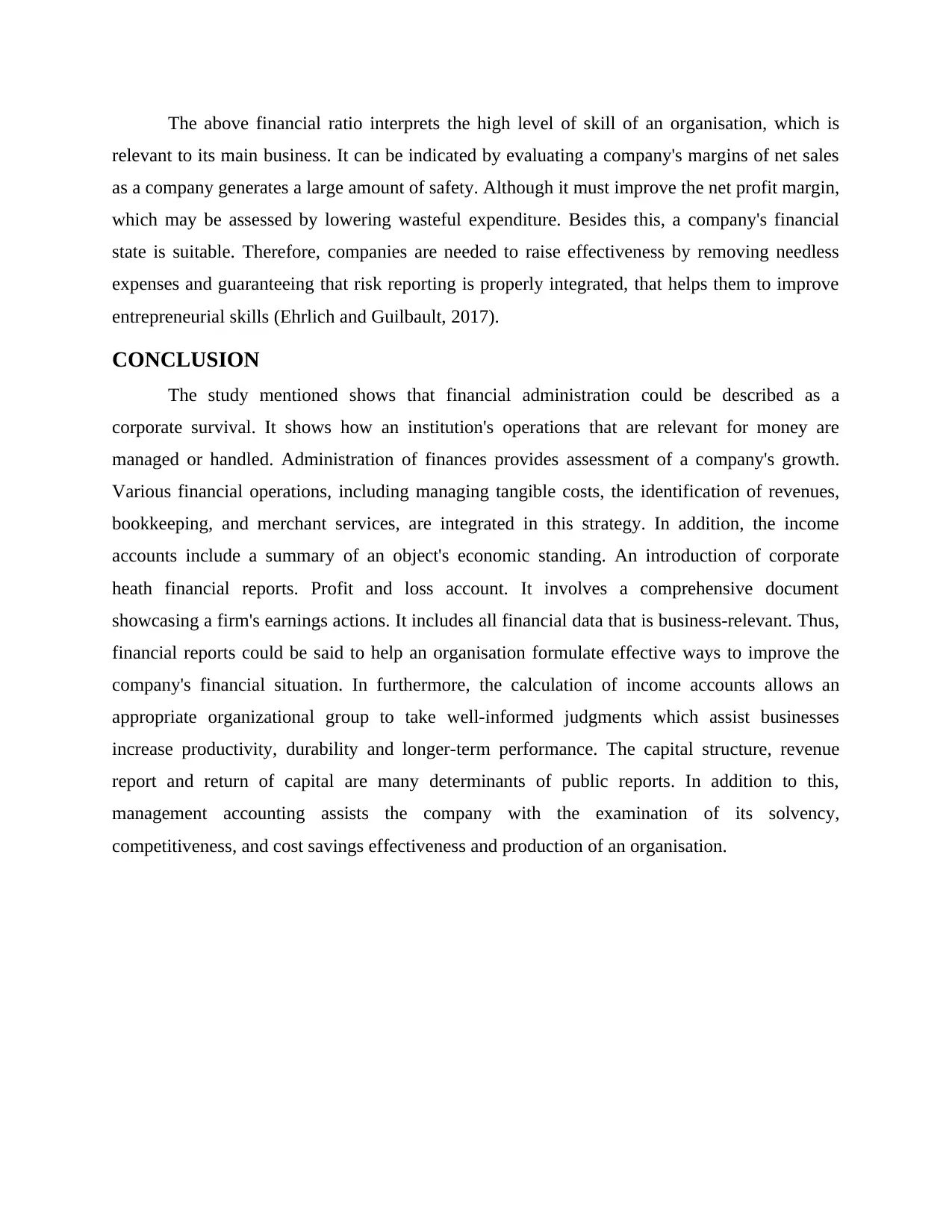
The above financial ratio interprets the high level of skill of an organisation, which is
relevant to its main business. It can be indicated by evaluating a company's margins of net sales
as a company generates a large amount of safety. Although it must improve the net profit margin,
which may be assessed by lowering wasteful expenditure. Besides this, a company's financial
state is suitable. Therefore, companies are needed to raise effectiveness by removing needless
expenses and guaranteeing that risk reporting is properly integrated, that helps them to improve
entrepreneurial skills (Ehrlich and Guilbault, 2017).
CONCLUSION
The study mentioned shows that financial administration could be described as a
corporate survival. It shows how an institution's operations that are relevant for money are
managed or handled. Administration of finances provides assessment of a company's growth.
Various financial operations, including managing tangible costs, the identification of revenues,
bookkeeping, and merchant services, are integrated in this strategy. In addition, the income
accounts include a summary of an object's economic standing. An introduction of corporate
heath financial reports. Profit and loss account. It involves a comprehensive document
showcasing a firm's earnings actions. It includes all financial data that is business-relevant. Thus,
financial reports could be said to help an organisation formulate effective ways to improve the
company's financial situation. In furthermore, the calculation of income accounts allows an
appropriate organizational group to take well-informed judgments which assist businesses
increase productivity, durability and longer-term performance. The capital structure, revenue
report and return of capital are many determinants of public reports. In addition to this,
management accounting assists the company with the examination of its solvency,
competitiveness, and cost savings effectiveness and production of an organisation.
relevant to its main business. It can be indicated by evaluating a company's margins of net sales
as a company generates a large amount of safety. Although it must improve the net profit margin,
which may be assessed by lowering wasteful expenditure. Besides this, a company's financial
state is suitable. Therefore, companies are needed to raise effectiveness by removing needless
expenses and guaranteeing that risk reporting is properly integrated, that helps them to improve
entrepreneurial skills (Ehrlich and Guilbault, 2017).
CONCLUSION
The study mentioned shows that financial administration could be described as a
corporate survival. It shows how an institution's operations that are relevant for money are
managed or handled. Administration of finances provides assessment of a company's growth.
Various financial operations, including managing tangible costs, the identification of revenues,
bookkeeping, and merchant services, are integrated in this strategy. In addition, the income
accounts include a summary of an object's economic standing. An introduction of corporate
heath financial reports. Profit and loss account. It involves a comprehensive document
showcasing a firm's earnings actions. It includes all financial data that is business-relevant. Thus,
financial reports could be said to help an organisation formulate effective ways to improve the
company's financial situation. In furthermore, the calculation of income accounts allows an
appropriate organizational group to take well-informed judgments which assist businesses
increase productivity, durability and longer-term performance. The capital structure, revenue
report and return of capital are many determinants of public reports. In addition to this,
management accounting assists the company with the examination of its solvency,
competitiveness, and cost savings effectiveness and production of an organisation.
⊘ This is a preview!⊘
Do you want full access?
Subscribe today to unlock all pages.

Trusted by 1+ million students worldwide
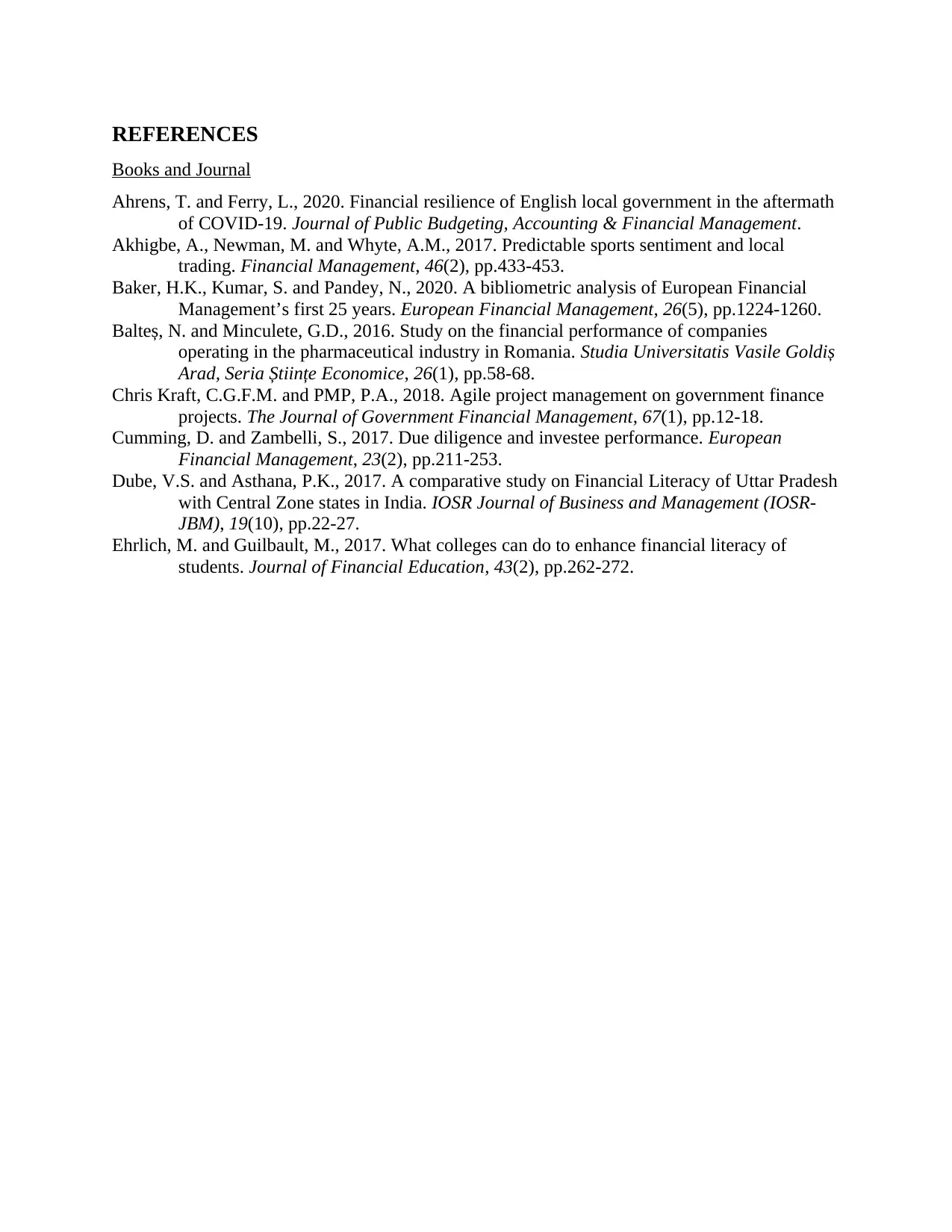
REFERENCES
Books and Journal
Ahrens, T. and Ferry, L., 2020. Financial resilience of English local government in the aftermath
of COVID-19. Journal of Public Budgeting, Accounting & Financial Management.
Akhigbe, A., Newman, M. and Whyte, A.M., 2017. Predictable sports sentiment and local
trading. Financial Management, 46(2), pp.433-453.
Baker, H.K., Kumar, S. and Pandey, N., 2020. A bibliometric analysis of European Financial
Managementʼs first 25 years. European Financial Management, 26(5), pp.1224-1260.
Balteș, N. and Minculete, G.D., 2016. Study on the financial performance of companies
operating in the pharmaceutical industry in Romania. Studia Universitatis Vasile Goldiș
Arad, Seria Științe Economice, 26(1), pp.58-68.
Chris Kraft, C.G.F.M. and PMP, P.A., 2018. Agile project management on government finance
projects. The Journal of Government Financial Management, 67(1), pp.12-18.
Cumming, D. and Zambelli, S., 2017. Due diligence and investee performance. European
Financial Management, 23(2), pp.211-253.
Dube, V.S. and Asthana, P.K., 2017. A comparative study on Financial Literacy of Uttar Pradesh
with Central Zone states in India. IOSR Journal of Business and Management (IOSR-
JBM), 19(10), pp.22-27.
Ehrlich, M. and Guilbault, M., 2017. What colleges can do to enhance financial literacy of
students. Journal of Financial Education, 43(2), pp.262-272.
Books and Journal
Ahrens, T. and Ferry, L., 2020. Financial resilience of English local government in the aftermath
of COVID-19. Journal of Public Budgeting, Accounting & Financial Management.
Akhigbe, A., Newman, M. and Whyte, A.M., 2017. Predictable sports sentiment and local
trading. Financial Management, 46(2), pp.433-453.
Baker, H.K., Kumar, S. and Pandey, N., 2020. A bibliometric analysis of European Financial
Managementʼs first 25 years. European Financial Management, 26(5), pp.1224-1260.
Balteș, N. and Minculete, G.D., 2016. Study on the financial performance of companies
operating in the pharmaceutical industry in Romania. Studia Universitatis Vasile Goldiș
Arad, Seria Științe Economice, 26(1), pp.58-68.
Chris Kraft, C.G.F.M. and PMP, P.A., 2018. Agile project management on government finance
projects. The Journal of Government Financial Management, 67(1), pp.12-18.
Cumming, D. and Zambelli, S., 2017. Due diligence and investee performance. European
Financial Management, 23(2), pp.211-253.
Dube, V.S. and Asthana, P.K., 2017. A comparative study on Financial Literacy of Uttar Pradesh
with Central Zone states in India. IOSR Journal of Business and Management (IOSR-
JBM), 19(10), pp.22-27.
Ehrlich, M. and Guilbault, M., 2017. What colleges can do to enhance financial literacy of
students. Journal of Financial Education, 43(2), pp.262-272.
Paraphrase This Document
Need a fresh take? Get an instant paraphrase of this document with our AI Paraphraser
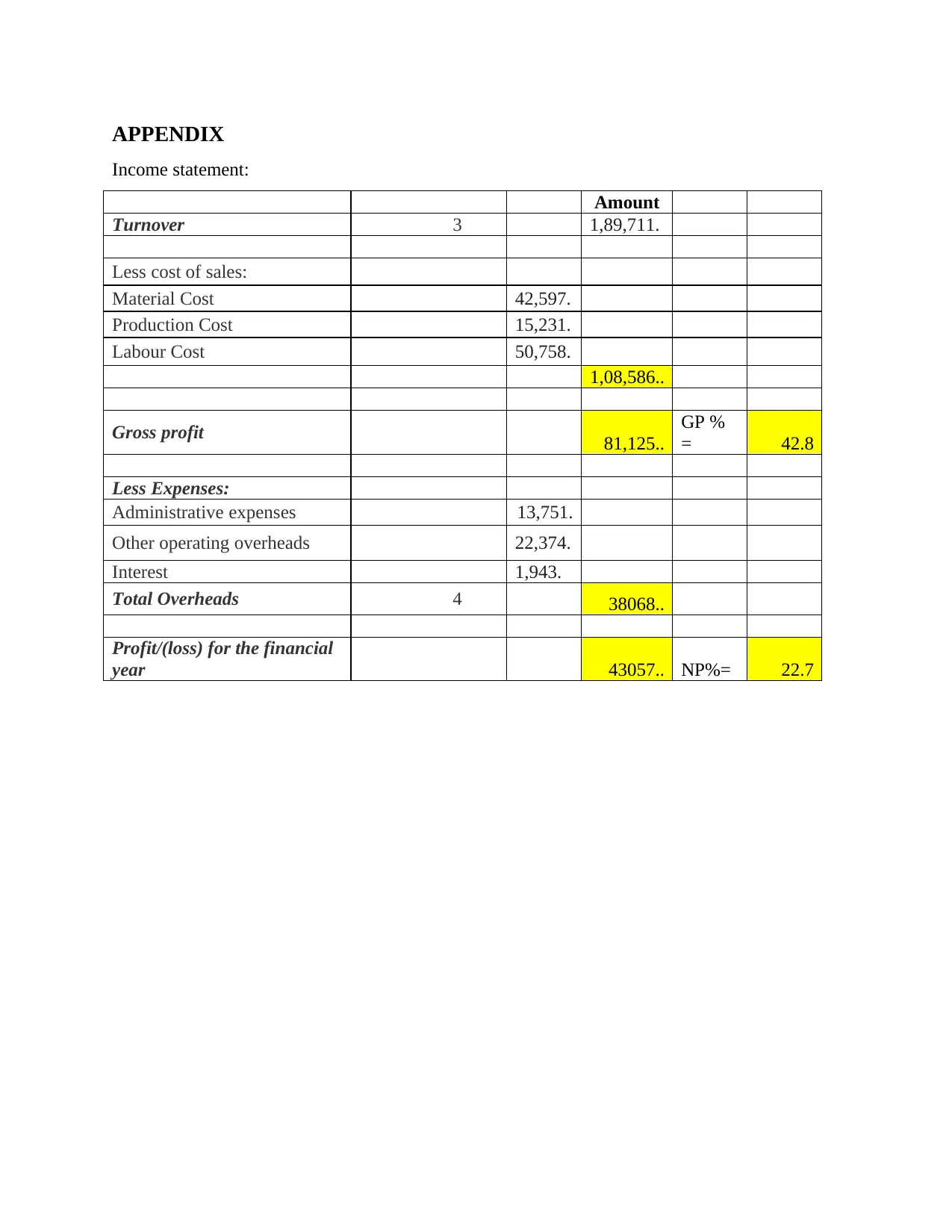
APPENDIX
Income statement:
Amount
Turnover 3 1,89,711.
Less cost of sales:
Material Cost 42,597.
Production Cost 15,231.
Labour Cost 50,758.
1,08,586..
Gross profit 81,125..
GP %
= 42.8
Less Expenses:
Administrative expenses 13,751.
Other operating overheads 22,374.
Interest 1,943.
Total Overheads 4 38068..
Profit/(loss) for the financial
year 43057.. NP%= 22.7
Income statement:
Amount
Turnover 3 1,89,711.
Less cost of sales:
Material Cost 42,597.
Production Cost 15,231.
Labour Cost 50,758.
1,08,586..
Gross profit 81,125..
GP %
= 42.8
Less Expenses:
Administrative expenses 13,751.
Other operating overheads 22,374.
Interest 1,943.
Total Overheads 4 38068..
Profit/(loss) for the financial
year 43057.. NP%= 22.7
1 out of 11
Related Documents
Your All-in-One AI-Powered Toolkit for Academic Success.
+13062052269
info@desklib.com
Available 24*7 on WhatsApp / Email
![[object Object]](/_next/static/media/star-bottom.7253800d.svg)
Unlock your academic potential
Copyright © 2020–2025 A2Z Services. All Rights Reserved. Developed and managed by ZUCOL.





